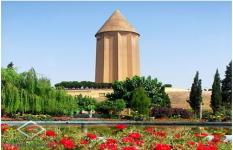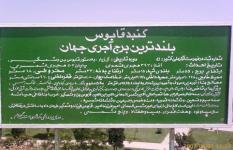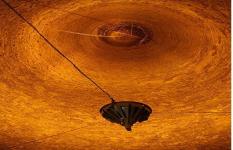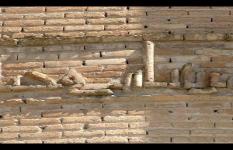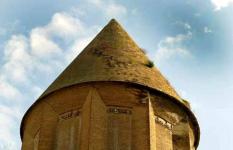This beautiful tower belongs to the 10th century when Qabus, son of Voshmgir, the Ziarid king, was ruling in Iran. The tower structure is simple and made of fired bricks, yet amazing and eye-catching, destinationiran.com wrote.
There are different opinions about the function of Gonbad-e Qabus Tower. Some believe that it was a burial structure and the place where Qabus Ibn-e Voshmgir, Ziarid ruler of approximately 10th and 11th centuries in northern Iran was buried. As archeologists have not found any corpses in the cellar, it is not possible to approve or disapprove this opinion.
Based on the relations between Qabus and scientists, men of letter and astronomers, others believe that Qabus had planned to build this structure for use as an observatory. These scholars refer to the historical sources where Qabus had ordered the construction of this building. Whatever the purpose of the construction is, Gonbad-e Qabus is at its glorious peak of ancient architecture and attracts the attention of the travelers who pass by the area. It is a witness to the history of art and architecture in Iran.
The architectural style of this building is the somewhat between Khorasan style and early Razi style. The builders have used fine materials in their works. For instance, they have used baked bricks for the entire structure. The quality of structure speaks for itself. It has survived the time, climate and many other harsh treatments.
The exterior body of Gonbad-e Qabus is circular and 52 meters high including its conical roof. The entire tower has been built on an artificial hill as high as 10 meters, which serves as the foundation of the structure. The inner perimeter of this tower is 30 meters and the outer perimeter is 60 meters. The inner diameter is 9.67 meters at the base.
Three parts of Gonbad-e Qabus Tower structure
● Foundation: As mentioned earlier, this tower is constructed on top of an artificial hill. It is made of bricks and the traditional Iranian concrete called ‘Sarooj’. Inside this foundation, there is a cellar like in any other tomb towers. Unfortunately, in the course of time, looters, who had searched for treasure at this section, have left very little of it.
● Body: There are buttresses with right angles surrounding it from outside and creating silhouettes adding to its beauty during the day. The construction of this tower on top of the hill, its slender-style and pointed roof have all helped it stand above the rest of the similar towers of the antiquity. There is one entrance looking at the southeast with trilobed niches decorating its top. This is one of the earliest examples of moqarnas (stalactite vaulting).
● Conical Roof: It is 18 meters high by itself with a nine-meter diameter space inside and at the base of the roof. The architect has used baked bricks for the construction of the roof too.
The architect has used sarooj and particular tailed bricks known as ‘Kafshaky’ for the construction of the roof. The roof has got two shells. Like in earthen-made domes, the inner shell is made in form of a half-egg and out of regular fired bricks, but the outer shell is made of tailed bricks.
This tomb tower is more than 1,000 years old despite having no deep foundation into the ground. It is so solidly standing in its place that has resisted large earthquakes with a magnitude of six in Richter scale.
Since no advanced technology existed at the time of the construction, the architect has used ‘Compaction’ method to compress the earth around the tower base in a spiral or stepped way around the façade. Eventually, this earth has formed a hill around the foot of the tower.
Decoration at Gonbad-e Qabus Tower
Dr. Wilson from the US University of Pennsylvania, who has carried out a research about this tower, said, “Further up, at a semi-circle style, one can see a moqarnas corner at the foot of the stalactite decoration that is the first instance of decorating the tower. There are Kufic inscriptions on both sides forming a belt around the trunk of the tower. One is eight meters high and the other one is just below the dome foot. The style is a simple Kufic brick-made embossed inscription that is easily readable. A brick-made frame has also surrounded it.”
Tomb towers in the history of Iran and their functions
In the antiquity, people built tower-like structures called ‘Meel’, ‘Menar’, ‘Cheraghdan’ or ‘Cheragh Payeh’ along the roads, routes and city boundaries.
Menar means the place for light and fire. In fact, they used to burn fire on top of these structures to show the way to the travelers at night or foggy days. Also, they used the light to convey messages to long distances. Ancient Iranians converted these towers to fire temples at the time of Sassanians (3rd to 7th centuries) and set Mubads (Zoroastrian priests) in charge of keeping the fire burning.
Iranians built tomb towers since before Islam for the people they revered. The tradition continued until the Arabs brought Islam to Iran in the seventh century. As the new religion was not in favor of building any memorial for the deceased ones, this tradition stopped for some time. However, Iranians made all their efforts to bring back this tradition to their communities even after they had converted to a new faith. The construction of these structures gained popularity again around 400 to 600 years after Islam, meaning in the 11th to 13th centuries.
Out of the tomb towers built in Iran during this era, 30 Meel or Menar are still left standing. The oldest one remained is in Mamasany town called ‘Meel-e Ezhdeha’, which belongs to Parthian Era.
If you are traveling to Golestan Province, this is a must-see. This province is at the northeast of Tehran and southeast of the Caspian Sea. It offers a lot of cultural attractions like the lifestyle of Turkmen tribes living there, Hyrcanian forest, etc.
With no doubt, prepare to visit Gonbad-e Qabus tomb tower during your visit as well. It is worth the time and effort to be at a place where it stands despite lots of historical events.

